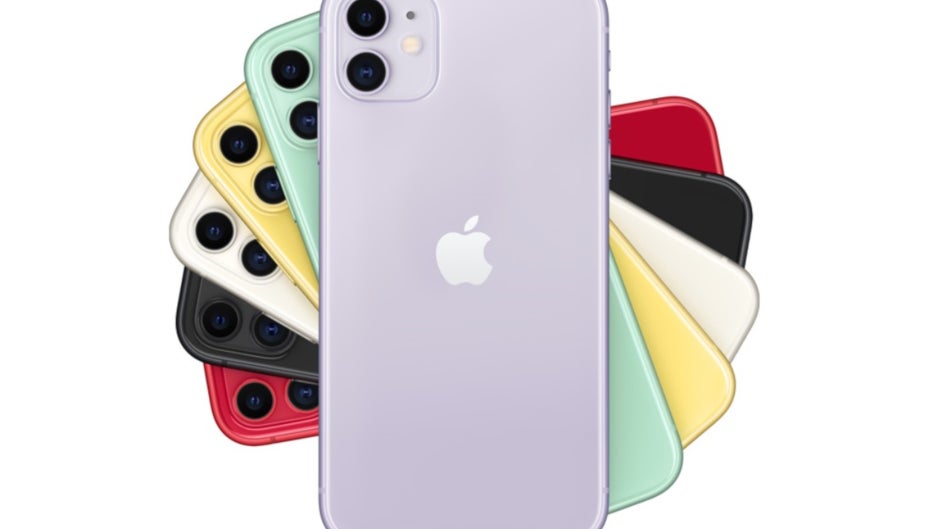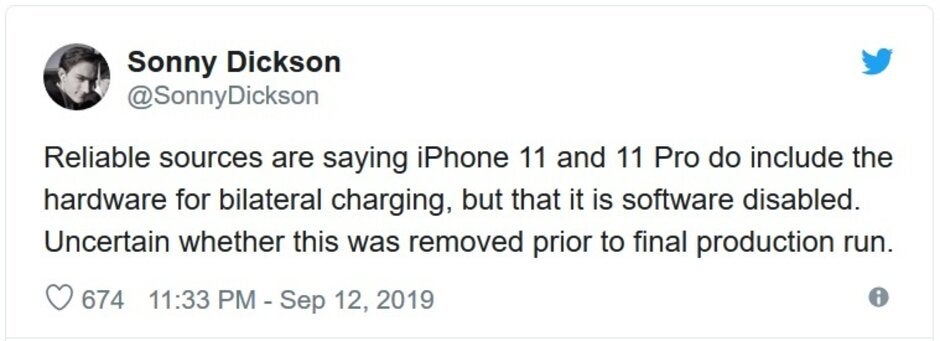Hardware for missing Apple iPhone feature rumored to be disabled inside the handsets

Throughout much of this year, we kept hearing that the 2019 Apple iPhones would have reverse wireless charging (aka bilateral wireless charging). This feature first debuted on 2018's Huawei Mate 20 Pro and Samsung named it Wireless PowerShare for the Samsung Galaxy S10 and Galaxy Note 10 series. Reverse wireless charging allows the user to flip his phone face down and use the back panel as though it were a wireless charging pad. For example, iPhone users would have been able to power up the AirPods wireless charging case, an Apple Watch, or compatible phone.
It wasn't until last Monday night, the evening before Apple's new product event, that reliable analyst Ming-Chi Kuo told clients that Apple had decided not to equip its new models with reverse wireless charging. The reason cited by Kuo was that Apple felt that the "charging efficiency may not meet Apple’s requirements." And sure enough, during the event last Tuesday, there was not one word mentioned about it.
The big improvement in battery life on the 2019 iPhone models could have been originally related to reverse wireless charging
But that is not the end of the story. On Thursday, Twitter tipster Sonny Dickson revealed via a tweet that he was told by reliable sources that the iPhone 11 and iPhone 11 Pro could contain the hardware needed to offer reverse wireless charging, but the hardware is said to be "software disabled." If true, this would be a strong indication that Apple's decision to disable the feature was pretty much a last-minute decision and might have occurred too late for it to remove the hardware from the phones.
Another sign that Apple might have originally decided to include reverse wireless charging on the 2019 iPhones is the nice sized jump in battery life for each model that Apple announced. The iPhone 11 has an additional hour of battery life, and the model it replaced (the iPhone XR) already had the longest battery life of any iPhone ever. The iPhone 11 Pro and iPhone 11 Pro Max have battery life increases of four and five hours respectively. Since reverse wireless charging uses the battery belonging to the host phone, Apple was expected to include more powerful batteries on the new handsets. In fact, earlier in the year when Kuo noted that Apple was planning on equipping the 2019 iPhones with larger batteries, he specifically said that it was to help support bilateral wireless charging.

The 2019 Apple iPhones might contain the hardware needed to offer reverse wireless charging
When it comes to wireless charging, this has not been a banner year for Apple. In March, it officially canceled the AirPower wireless charging pad that it first unveiled on September 12th, 2017. At that event, Apple also introduced the iPhone 8, iPhone 8 Plus and the iPhone X. The pad was supposed to be able to charge the AirPods wireless charging case, an Apple Watch and a compatible phone all at the same time. Despite little clues indicating that AirPower was still alive (including a diagram on the retail box of the second-generation AirPods that showed a sketch of the product being used with the wireless Bluetooth earbuds), after 562 days Apple finally turned the lights off on the overly ambitious accessory.
As for the reverse wireless hardware that may be inside the new iPhones, it doesn't appear that Apple plans on enabling the feature with a software update anytime soon. And frankly, it isn't clear that the lack of reverse wireless charging is going to cost Apple that many iPhone sales anyway. Instead, the manufacturer is counting on the upgraded camera systems, the larger batteries and the improved water resistance to drive sales of the latest iPhone models.
Follow us on Google News









![A new Android bug is making it impossible to install new apps. Are you affected? [UPDATE]](https://m-cdn.phonearena.com/images/article/176703-wide-two_350/A-new-Android-bug-is-making-it-impossible-to-install-new-apps.-Are-you-affected-UPDATE.webp)

Things that are NOT allowed:
To help keep our community safe and free from spam, we apply temporary limits to newly created accounts: